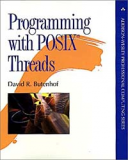Книга: Programming with POSIX® Threads
8.2.1 Beware of concurrent serialization
8.2.1 Beware of concurrent serialization
The ideal parallel code is a set of tasks that is completely compute-bound. They never synchronize, they never block — they just "think." If you start with a program that calls three compute-bound functions in series, and change it to create three threads each running one of those functions, the program will run (nearly) three times faster. At least, it should do so if you're running on a multiprocessor with at least three CPUs that are, at that moment, allocated for your use.
The ideal concurrent code is a set of tasks that is completely I/O-bound. They never synchronize, and do little computation — they just issue I/O requests and wait for them. If you start with a program that writes chunks of data to three separate files (ideally, on three separate disks, with separate controllers), and change it to create three threads, each writing one of those chunks of data, all three I/O operations can progress simultaneously.
But what if you've gone to all that trouble to write a set of compute-bound parallel or I/O-bound concurrent threads and it turns out that you've just converted a straight-line serialized program into a multithreaded serialized program? The result will be a slower program that accomplishes the same result with substantially more overhead. Most likely, that is not what you intended. How could that have happened?
Let's say that your compute-bound operations call malloc and free in their work. Those functions modify the static process state, so they need to perform some type of synchronization. Most likely, they lock a mutex. If your threads run in a loop calling malloc and free, such that a substantial amount of their total time may be spent within those functions, you may find that there's very little real parallelism. The threads will spend a lot of time blocked on the mutex while one thread or another allocates or frees memory.
Similarly, the concurrent I/O threads may be using serialized resources. If the threads perform "concurrent" I/O using the same stdioFILE stream, for example, they will be locking mutexes to update the stream's shared buffer. Even if the threads are using separate files, if they are on the same disk there will be locking within the file system to synchronize the file cache and so forth. Even when using separate disks, true concurrency may be subject to limitations in the I/O bus or disk controller subsystems.
The point of all this is that writing a program that uses threads doesn't magically grant parallelism or even concurrency to your application. When you're analyzing performance, be aware that your program can be affected by factors that aren't within your control. You may not even be able to see what's happening in the file system, but what you can't see can hurt you.




